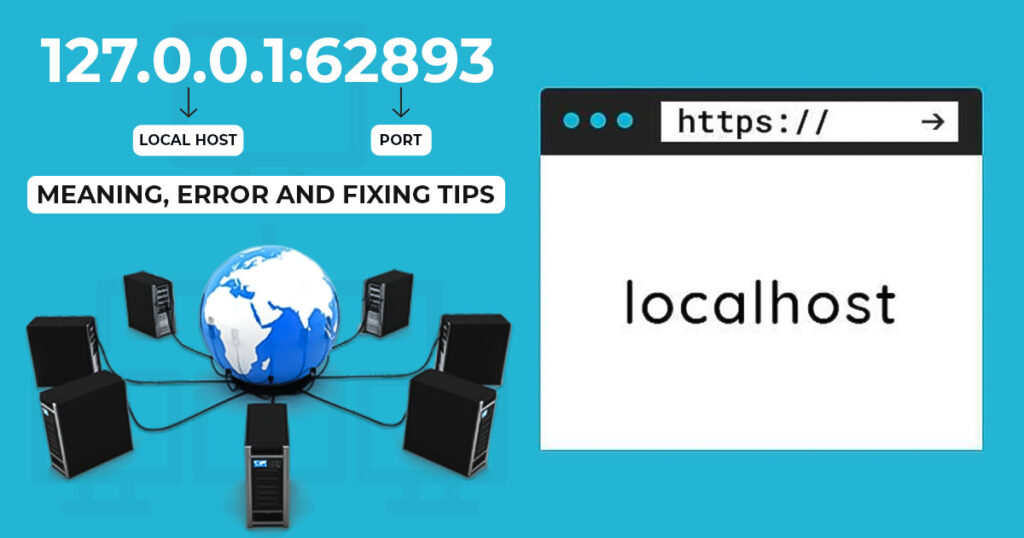Introduction
The phrase “127.0.0.1:62893” might seem cryptic to many, but for those involved in web development, networking, or IT, it’s a familiar sight. This combination of an IP address and port number serves as a fundamental tool in various technical processes, especially when testing applications in a local environment. By diving deeper into the concept of 127.0.0.1:62893, we can unravel its role in ensuring seamless local development and testing. Understanding this address is crucial for anyone looking to build, test, or maintain software effectively.
What is 127.0.0.1?
127.0.0.1, often referred to as “localhost,” is the loopback IP address used by a computer to point to itself. This IP address is reserved exclusively for this purpose across all devices and networks. When a computer accesses 127.0.0.1, it’s essentially communicating with itself, which is invaluable for testing and development. The loopback address allows developers to run and test applications on their local machines without the need for an active internet connection.
Why is 127.0.0.1 Known as Localhost?
The term “localhost” is synonymous with 127.0.0.1 because it represents the same concept: the computer’s self-referential address. Localhost is a hostname that translates to the IP address 127.0.0.1. When you type “localhost” in your browser, it’s essentially the same as entering 127.0.0.1, directing the request back to your machine. This mechanism is part of the network’s design to ensure that a computer can always reference itself reliably.
The Purpose of Loopback Addresses
Loopback addresses like 127.0.0.1 are vital in network configurations. They are used to test networking software, server configurations, and other applications without the need for an external network. This setup is particularly important for developers who need to verify that their software behaves as expected before deploying it to a live environment. The loopback mechanism is a core feature of the Internet Protocol Suite, ensuring that internal communications on a device can be handled efficiently.
Understanding Port 62893
Port numbers are another critical component of networking. They are used to differentiate various services and applications on a single device. In the context of 127.0.0.1:62893, the number “62893” is the port where a particular service or application listens for incoming traffic. Every network service or application running on a computer uses a unique port number to ensure that data reaches the correct destination.
The Role of Port Numbers in Networking
Port numbers, ranging from 0 to 65535, are divided into different categories: well-known ports (0-1023), registered ports (1024-49151), and dynamic or private ports (49152-65535). Port 62893 falls into the dynamic range, often used for custom applications or temporary services. When a service starts on a local machine, it may bind to a dynamic port like 62893 to handle specific tasks, especially during development and testing.
Why Use Dynamic Ports Like 62893?
Dynamic ports are often selected by the operating system when a service or application does not need a fixed port number. These ports are ideal for temporary connections, testing environments, and scenarios where multiple instances of a service might be running simultaneously. Using a dynamic port like 62893 ensures that developers do not interfere with standard services that may require specific, reserved ports.
How 127.0.0.1:62893 Facilitates Local Development
In local development, 127.0.0.1:62893 is commonly used to host and test applications on a developer’s machine. By running the application on this address, developers can simulate how it will behave in a live environment. This setup allows for debugging, monitoring, and refining software in a controlled environment before it’s exposed to real users.
Setting Up a Local Server on 127.0.0.1:62893
Setting up a local server is a straightforward process for most developers. Tools like XAMPP, WAMP, or even Node.js allow developers to start a server on their localhost. By specifying a port number, like 62893, they can run multiple servers simultaneously without conflict. For example, a developer might run a web application on port 8080 and a database management tool on 62893, ensuring that each service operates independently.
Testing Applications with 127.0.0.1:62893
Testing applications on 127.0.0.1:62893 is an essential step in the development lifecycle. By accessing the application through this address, developers can ensure that all components work together as intended. They can simulate user interactions, test database connections, and validate the overall functionality of the application. This process helps identify bugs, performance issues, and security vulnerabilities early on, reducing the risks associated with deployment.
Security Implications of Using 127.0.0.1:62893
While using 127.0.0.1 and dynamic ports like 62893 is generally safe in a local environment, there are security considerations to be aware of. Since localhost connections are restricted to the local machine, they are not exposed to external networks. However, developers must ensure that no sensitive data is inadvertently exposed through these local servers, especially if they are running other applications or services that might interact with the localhost.
Protecting Sensitive Information on Localhost
To protect sensitive information, developers should use secure coding practices even when working on localhost. This includes validating inputs, sanitizing data, and using secure protocols. Additionally, they should monitor network traffic on the localhost to ensure that no unauthorized access occurs. Even though 127.0.0.1:62893 is not accessible from the outside world, it’s still essential to treat local development with the same care as a production environment.
Potential Risks of Misconfigured Local Servers
Misconfigured local servers can inadvertently expose services to the broader network, especially if the network configuration changes or if the developer uses tools that bypass standard security measures. Developers should regularly review their local server settings, ensure firewalls are active, and avoid running unnecessary services that could create security vulnerabilities.
Common Issues When Using 127.0.0.1:62893
Despite the convenience of using 127.0.0.1:62893 for local development, developers may encounter several common issues. These can range from port conflicts to firewall restrictions, all of which can impede the development process.
Port Conflicts and Resolution
One of the most common issues is port conflicts, where another service on the local machine is already using the desired port. When this happens, the server may fail to start, or the application might behave unpredictably. Resolving port conflicts involves identifying which service is using the port and either stopping that service or choosing a different port for the new service.
Firewall Restrictions
Firewalls are designed to protect a computer by blocking unauthorized access, but they can also interfere with local development. If a firewall blocks port 62893, the application running on that port will be inaccessible, even on localhost. Developers need to configure their firewalls to allow traffic on the necessary ports or temporarily disable the firewall during testing.

Best Practices for Using 127.0.0.1:62893
To make the most of 127.0.0.1:62893, developers should follow best practices that ensure smooth and secure local development.
Consistent Port Management
Using consistent port management strategies is crucial in avoiding conflicts and ensuring that applications run smoothly. Developers should document which ports are used for which services and avoid assigning ports arbitrarily. Tools like Docker can also help by isolating applications and managing ports more efficiently.
Regular Testing and Monitoring
Regular testing on 127.0.0.1:62893 helps catch issues early in the development process. Developers should frequently test their applications, paying close attention to how they behave under different conditions. Monitoring tools can provide insights into performance and potential bottlenecks, allowing for proactive improvements.
Secure Development Practices
Even though localhost is generally safe, adopting secure development practices is vital. This includes using encryption where necessary, implementing strong authentication mechanisms, and ensuring that any dependencies or libraries used are up to date and free from vulnerabilities.
Conclusion
The combination of 127.0.0.1 and port 62893 is more than just a random string of numbers; it’s a powerful tool in the realm of software development and testing. By leveraging this address and port, developers can create a controlled, isolated environment that mirrors a production setup, allowing them to build, test, and refine their applications with confidence. Understanding the nuances of 127.0.0.1:62893, from its role in local development to best practices for secure usage, is essential for any developer aiming to produce reliable and robust software.
Also Read: Internet Chicks: Shaping Digital Communities and Culture
FAQs
What is 127.0.0.1:62893 used for?
127.0.0.1:62893 is used for local development and testing. It refers to the localhost IP address (127.0.0.1) and a specific port number (62893) where a service or application runs.
Can I change the port number from 62893 to something else?
Yes, you can change the port number to any other available port. This is often done to avoid conflicts or to organize services running on different ports.
Is it safe to use 127.0.0.1:62893 for testing?
Yes, it is generally safe to use 127.0.0.1:62893 for testing because it is limited to the local machine. However, developers should still follow secure coding practices to protect sensitive information.
Why am I unable to access 127.0.0.1:62893?
If you cannot access 127.0.0.1:62893, it could be due to a port conflict, firewall restrictions, or the service not running on the specified port. Checking these factors can help resolve the issue.
What are dynamic ports, and why are they used?
Dynamic ports are temporary ports typically used by the operating system when an application does not require a fixed port. They help manage multiple services and reduce the risk of conflicts.
How do I secure applications running on 127.0.0.1:62893?
To secure applications running on 127.0.0.1:62893, use secure coding practices, validate and sanitize inputs, and monitor network traffic. Ensure that sensitive data is protected even during local development.












